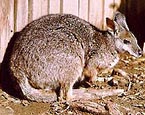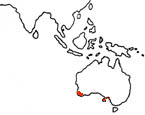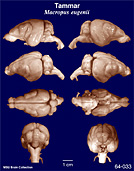|
Tammar
Wallaby
(Macropus eugenii) #64-33 |
||||
|
|
Physical
characteristics and distribution
|
|
Significant sexual dimorphism exists between the males and the females of this species, with males growing to be larger. The maximum recorded weight in males is 9.1 kg, while in females it is 6.9 kg. The body length is 59 to 68 cm in males and 52 to 63 cm in females. Both males and females are about 45 cm in height. The tails of males range from 38 to 45 cm and that of females from 33 to 44 cm. They have a greyish brown pelage and reddish shoulders. As with most wallabies, the hind quarters are powerful and well-developed and the strong, tapered tail is used for balance. The tail acts as rudder when in motion and as a third leg while seated, being strong enough to support the full weight of the animal.
|
|
Description
of the brain
|
|
Animal
source and preparation
|
|
All
specimens collected followed the same preparation
and histological procedure.
|
Other Related Resources (websites and publications)
List of Specimens | Explore Collections | Brain Sections | Brain Evolution | Brain Development | Brain Circuitry | Brain Functions | Location and Use | Related Web Sites | Contact Us | Search MSU Database | Personnel | Home



